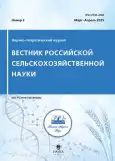Application of molecular hydrogen in artificial insemination of cows
- Авторлар: Ivashchenko M.N.1,2, Deryuginа A.V.1, Belov A.A.1,2, Erzutov A.I.2, Petrov V.A.2
-
Мекемелер:
- National Research Nizhny Novgorod State University named after N.I. Lobachevsky
- Nizhny Novgorod State Agrotechnological University named after L.I. Florentyev
- Шығарылым: № 2 (2025)
- Беттер: 81-84
- Бөлім: Zootechnics
- URL: https://journal-vniispk.ru/2500-2082/article/view/293990
- DOI: https://doi.org/10.31857/S2500208225020164
- EDN: https://elibrary.ru/HVLQGL
- ID: 293990
Дәйексөз келтіру
Аннотация
The paper evaluates the effectiveness of artificial insemination of cows with sperm containing molecular hydrogen. The study was conducted on black-and-white cows of the second lactation. Two groups of animals were formed according to the principle of analog groups (control and experimental), with 50 heads each. The cows of the control group were inseminated with sperm frozen in a BioXcell medium, and the animals of the experimental group were inseminated with sperm frozen in a BioXcell medium with molecular hydrogen. To assess the initial functional state of the body, clinical studies and a comprehensive obstetric and gynecological examination were conducted before the start of the experiment. Insemination of cows was carried out by a group method by synchronizing sexual hunting according to the “Ovsinh” scheme. The effectiveness of insemination was evaluated on the basis of rectal ultrasound examination data on days 35 and 90 after insemination. The obtained results showed that the use of molecular hydrogen in the composition of the medium for diluting the seed makes it possible to increase the fertilizing ability of bull sperm and increase the percentage of pregnancy of cows during artificial insemination. Thus, the inclusion of molecular hydrogen in the composition of the solution for diluting the semen of cattle is advisable.
Негізгі сөздер
Толық мәтін
Авторлар туралы
Marina Ivashchenko
National Research Nizhny Novgorod State University named after N.I. Lobachevsky; Nizhny Novgorod State Agrotechnological University named after L.I. Florentyev
Хат алмасуға жауапты Автор.
Email: kafedra2577@mail.ru
PhD in Biological Sciences
Ресей, Nizhny NovgorodAnna Deryuginа
National Research Nizhny Novgorod State University named after N.I. Lobachevsky
Email: kafedra2577@mail.ru
Grand PhD in Biological Sciences
Ресей, Nizhny NovgorodAndrey Belov
National Research Nizhny Novgorod State University named after N.I. Lobachevsky; Nizhny Novgorod State Agrotechnological University named after L.I. Florentyev
Email: kafedra2577@mail.ru
PhD in Biological Sciences
Ресей, Nizhny NovgorodAlexey Erzutov
Nizhny Novgorod State Agrotechnological University named after L.I. Florentyev
Email: kafedra2577@mail.ru
Ресей, Nizhny Novgorod
Vladimir Petrov
Nizhny Novgorod State Agrotechnological University named after L.I. Florentyev
Email: kafedra2577@mail.ru
PhD Student
Ресей, Nizhny NovgorodӘдебиет тізімі
- Abilov A.I., Plemyashov K.V., Kombarova N.A. i dr. Nekotorye aspekty vosproizvodstva krupnogo rogatogo skota. SPb, 2019. 304 s.
- Antonov M.P. Vliyanie biohimicheskih izmenenij lipidov spermatozoidov i spermoplazmy na fertil’nost’ eyakulyata // Verhnevolzhskij medicinskij zhurnal. 2012. № 3. S. 47–50.
- Budevich A.I., Mordan’ G.G. Sovershenstvovanie tekhnologii iskusstvennogo osemeneniya krupnogo rogatogo skota // Vesti Akademii agrarnyh nauk Respubliki Belarus’. Ser. s.-h. nauk. 2002. № 3. S. 77–79.
- Deryugina A.V., Ivashchenko M.N., Lodyanoj M.S. Ocenka rezistentnosti membran spermatozoidov bykov v processe dolgosrochnogo hraneniya // Estestvennye i tekhnicheskie nauki. 2022. T. 1 (164). S. 107–109.
- Duvakina E.V. Osemenenie krupnogo rogatogo skota // Molodezh’ i nauka. 2019. № 9. S. 30.
- Kuleshova A.I., Safronov S.L. Sovremennye metody vosproizvodstva stada krupnogo rogatogo skota, ih preimushchestva i nedostatki // Vestnik Studencheskogo nauchnogo obshchestva. 2018. T. 9. № 1. S. 189–191.
- Kondrahin I.P., Arhipov A.V., Levchenko V.I. Metody veterinarnoj klinicheskoj laboratornoj diagnostiki: spravochnik. M.: KolosS, 2004. 520 s.
- Piskarev I.M., Ivanova I.P., Samodelkin A.G., Ivashchenko M.N. Iniciirovanie i issledovanie svobodno-radikal’nyh processov v biologicheskih eksperimentah. Nizhnij Novgorod, 2016. 106 s.
- Rahmanin Yu.A., Egorova N.A., Mihajlova R.I. Molekulyarnyj vodorod: biologicheskoe dejstvie, vozmozhnosti primeneniya v zdravoohranenii (obzor) // Gigiena i sanitariya. 2019. T. 98. № 4. S. 359–365.
- Ernst L.K., Subbotin A.D. Iskusstvennoe osemenenie – glavnyj faktor geneticheskogo progressa i rosta produktivnosti zhivotnovodstva // K 100-letiyu so dnya rozhdeniya osnovopolozhnika biologii vosproizvedeniya i tekhnologii iskusstvennogo osemeneniya akademika VASHNIL B.K. Milovanova: mat. Mezhd. nauch.-prakt. konf. Dubrovicy, 2004. S. 10–29.
- Bjelakovic G., Nikolova D., Gluud L. et al. Antioxidant supplements for prevention of mortality in healthy participants and patients with various diseases // Cochrane Database Syst. Rev. 2012. V. 3. CD007176.
- Finkel T., Holbrook N. Oxidants, oxidative stress and the biology of ageing // Nature. 2000. V. 408 (6809). PР. 239–247.
- Katakura M. Hydrogen-rich water inhibits glucose and alpha, beta –dicarbonyl compound-induced reactive oxygen species production in the SHR.Cg-Leprcp/NDmcr rat kidney. Med Gas Res. 2012. 2 (1). РР. 18–10.
- Kimura H. Hydrogen sulfide: from brain to gut // Antioxid. Redox Signal. 2010. V. 12 (9). PР. 1111–1123.
- Smith R., Murphy M. Mitochondria-targeted antioxidants as therapies // Discov. Med. 2011. V. 11 (57). PР. 106–114.
- Shi P, Sun W. A hypothesis on chemical mechanism of the effect of hydrogen. Med Gas Res. 2012. 2 (1). РР. 17–10.
- Ohsawa I., Ishikawa M., Takahashi K. Hydrogen acts as a therapeutic antioxidant by selectively reducing cytotoxic oxygen radicals // Nat. Med. 2007. V. 13. № 6. РP. 688–694.
- Ohta S. Molecular hydrogen as a preventive and therapeutic medical gas: initiation, development and potential of hydrogen medicine // Pharmacol. Ther. 2014. V. 144. № 1. PР. 1–11.
- Xie K., Yu Y., Pei Y., Hou L. Protective effects of hydrogen gas on murine polymicrobal sepsis via reducing oxidative stress and HMGB1 release // Shock. 2010. V. 34. № 1. PР. 90–97.
Қосымша файлдар









